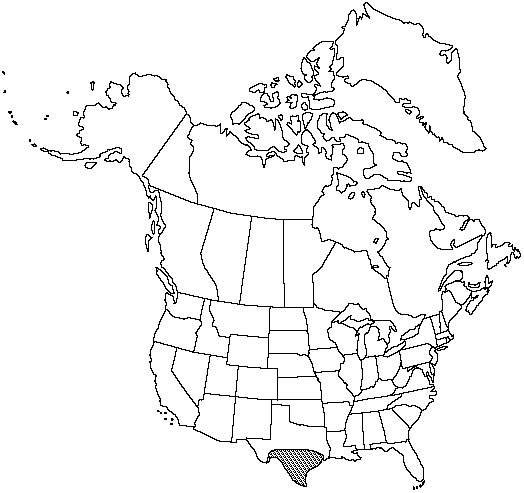Difference between revisions of "Pellaea ovata"
Contr. Gray Herb. 114: 34. 1936 Pteris ovata Desvaux, Mém. Soc. Lin. 1827.
FNA>Volume Importer |
FNA>Volume Importer |
||
| Line 17: | Line 17: | ||
}}<!-- | }}<!-- | ||
| − | --><span class="statement" id="st- | + | --><span class="statement" id="st-undefined" data-properties=""><b>Stems </b>creeping, horizontal, slender, 2–5 mm diam.; scales mostly bicolored, lanceolate, largest scales 0.3–0.8 mm wide, centers black, thick, margins brown, thin, erose-dentate. <b>Leaves</b> monomorphic, clustered or scattered along stem, 15–100 cm; croziers pubescent, bearing a few scales. <b>Petiole</b> straw-colored, tan, or gray, not lustrous, rounded or slightly flattened adaxially, without prominent articulation lines. <b>Blade</b> elongate-deltate, usually 3-pinnate proximally, 5–25 cm wide; rachis tan throughout, strongly flexuous, rounded or flattened adaxially, usually glabrous. <b>Pinnae</b> retrorse, projecting downward toward base of leaf, not decurrent on rachis, with 5–40 ultimate segments; costae strongly flexuous, 25–120 mm, longer than ultimate segments. <b>Ultimate</b> segments lanceolate-deltate, 5–20 mm, leathery, glabrous or sparsely pubescent; margins recurved on fertile segments, covering less than 1/2 abaxial surface, borders whitish, entire; apex obtuse to truncate. <b>Veins</b> of ultimate segments obscure. <b>Sporangia</b> short-stalked, containing 64 spores, not intermixed with farina-producing glands. <b>2n</b> = 58.</span><!-- |
-->{{Treatment/Body | -->{{Treatment/Body | ||
| + | |phenology=Sporulating summer–fall. | ||
|habitat=Rocky slopes and ledges, leaves often supported by associated vegetation, on a variety of substrates including granite and limestone | |habitat=Rocky slopes and ledges, leaves often supported by associated vegetation, on a variety of substrates including granite and limestone | ||
|elevation=300–1700 m | |elevation=300–1700 m | ||
| Line 39: | Line 40: | ||
|basionyms= | |basionyms= | ||
|family=Pteridaceae | |family=Pteridaceae | ||
| + | |phenology=Sporulating summer–fall. | ||
|habitat=Rocky slopes and ledges, leaves often supported by associated vegetation, on a variety of substrates including granite and limestone | |habitat=Rocky slopes and ledges, leaves often supported by associated vegetation, on a variety of substrates including granite and limestone | ||
|elevation=300–1700 m | |elevation=300–1700 m | ||
| Line 46: | Line 48: | ||
|publication year=1827 | |publication year=1827 | ||
|special status= | |special status= | ||
| − | |source xml=https://jpend@bitbucket.org/aafc-mbb/fna- | + | |source xml=https://jpend@bitbucket.org/aafc-mbb/fna-data-curation.git/src/9216fc802291cd3df363fd52122300479582ede7/coarse_grained_fna_xml/V2/V2_483.xml |
|genus=Pellaea | |genus=Pellaea | ||
|species=Pellaea ovata | |species=Pellaea ovata | ||
| − | |||
| − | |||
| − | |||
| − | |||
| − | |||
| − | |||
| − | |||
| − | |||
| − | |||
| − | |||
| − | |||
| − | |||
| − | |||
| − | |||
| − | |||
| − | |||
| − | |||
| − | |||
| − | |||
| − | |||
| − | |||
| − | |||
| − | |||
| − | |||
| − | |||
| − | |||
| − | |||
| − | |||
| − | |||
| − | |||
| − | |||
| − | |||
| − | |||
| − | |||
| − | |||
| − | |||
| − | |||
| − | |||
| − | |||
| − | |||
| − | |||
| − | |||
| − | |||
| − | |||
| − | |||
| − | |||
| − | |||
| − | |||
}}<!-- | }}<!-- | ||
-->[[Category:Treatment]][[Category:Pellaea]] | -->[[Category:Treatment]][[Category:Pellaea]] | ||
Revision as of 14:21, 27 July 2019
Stems creeping, horizontal, slender, 2–5 mm diam.; scales mostly bicolored, lanceolate, largest scales 0.3–0.8 mm wide, centers black, thick, margins brown, thin, erose-dentate. Leaves monomorphic, clustered or scattered along stem, 15–100 cm; croziers pubescent, bearing a few scales. Petiole straw-colored, tan, or gray, not lustrous, rounded or slightly flattened adaxially, without prominent articulation lines. Blade elongate-deltate, usually 3-pinnate proximally, 5–25 cm wide; rachis tan throughout, strongly flexuous, rounded or flattened adaxially, usually glabrous. Pinnae retrorse, projecting downward toward base of leaf, not decurrent on rachis, with 5–40 ultimate segments; costae strongly flexuous, 25–120 mm, longer than ultimate segments. Ultimate segments lanceolate-deltate, 5–20 mm, leathery, glabrous or sparsely pubescent; margins recurved on fertile segments, covering less than 1/2 abaxial surface, borders whitish, entire; apex obtuse to truncate. Veins of ultimate segments obscure. Sporangia short-stalked, containing 64 spores, not intermixed with farina-producing glands. 2n = 58.
Phenology: Sporulating summer–fall.
Habitat: Rocky slopes and ledges, leaves often supported by associated vegetation, on a variety of substrates including granite and limestone
Elevation: 300–1700 m
Distribution

Tex., Mexico, West Indies in Hispaniola, Central America, South America.
Discussion
Populations of Pellaea ovata in the flora are composed of sexual diploids; an apogamous triploid cytotype predominates south of the United States. I have not seen herbarium specimens to substantiate reports of P. ovata from New Mexico (D. B. Lellinger 1985).
Selected References
None.